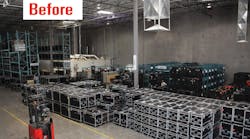By 2018, more than one-third of respondents surveyed by Motorola (35 percent) plan to increase the number of warehouses and distribution centers they operate, representing a 71 percent increase from current expansion plans in action today. The Motorola Solutions Future of Warehousing Survey polled warehouse IT and operations professionals in the manufacturing, retail, wholesale and third-party logistics (3PL) markets on the state of warehousing today and their vision for warehousing and distribution in the future.
The most commonly cited reasons for the expansion of storage and distribution networks include a mix of cost-savings and revenue-growth initiatives such as, lower transportation costs (36 percent), shorter delivery times (35 percent), new suppliers and trading partner locations (31 percent) and heightened omni-channel pressures (11 percent). (See infographic showing survey results here.)
Researchers concluded that as the industry moves to reduce order fulfillment costs and increase worker efficiency and productivity, the picking and replenishment solutions of the next five years will shift more toward true multimodal operation, with a 142 percent increase in the integration of voice-directed and screen-directed picking on flexible mobile devices along with a 113 percent increase for voice-, scan- and keyed-response workflows.
Warehouse professionals who responded indicated they expect a shift away from pen and paper-based processes (71 percent decrease) to handheld mobile computers and tablets (100 percent increase) for cycle counting and inventory validation by 2018.
Overall, the pace of supply chain re-evaluation and optimization is quickening as nearly two-thirds (67 percent) of respondents claimed that they are either constantly or annually re-evaluating their supply chain networks.
While only 67 percent of items received at a warehouse are bar coded today, respondents expect supplier management initiatives and trading partner compliance requirements to drive higher utilization in the coming years – reaching an estimated 84 percent by 2018.
Organizations seek to reduce the average training time it takes a new worker to hit full productivity by 44 percent (from 48 hours to 27 hours), while at the same time preparing employees to perform more types of procedures during a single shift as a result of a planned 60 percent increase in the use of task interleaving.
More than one-quarter (26 percent) of respondents reported that company management views warehouses and distribution centers as an asset that can drive growth for the business.
“Warehousing and distribution have not traditionally been the most celebrated functions within leading businesses across manufacturing, retail and wholesale industries,” said Mark Wheeler, director of warehouse solutions, Motorola Solutions. “But [this survey reveals that] these functions are playing a more important role as businesses in these industries face new pressures to cut costs to enhance profitability and free up capital as well as drive competitive differentiation and business growth.”
The survey was targeted to IT and operational professionals in the logistics, manufacturing, retail and wholesale market segments who work for firms that have at least $15 million in annual revenues. 328 respondents completed the survey without knowledge of Motorola Solutions’ sponsorship.



